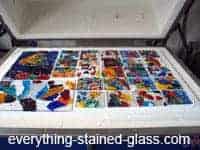Can I Speed My Glass Kiln Up?

Project With Glass Frit
After a 5 day kiln glass course during a trip home to England last October, I decided I had to have my own kiln here in Bangkok where I live. It’s taken from then till a month ago – but I finally have my kiln.
My main problem now is that I have not been able to find anyone else here working in glass, so I am literally on my own (thank goodness for the internet!!!) – having fun, but needing a good sense of humour as I look at some of the results that come out of my kiln!! Whilst I learn the personality of my kiln and get the hang of the technicalities involved, I’m just using bottles (I like the idea of recycling anyway) rather than use expensive materials.
I could ask so many questions…. but here is the one I would most like answered. I have a fairly large kiln – 100 x 70cm interior measurements, with a Stafford controller. (It was manufactured locally by a company that usually make ceramic kilns, by the way.) It is extremely well insulated and takes an incredibly long time to cool down. For instance, I ran a firing schedule that I started on Thursday morning. By early afternoon I had flash cooled down from 800C to 550C. The annealing, cooling and reaching room temperature then took until this morning. Is this normal? The kiln had reached the end of the programmed schedule by Thursday evening. By yesterday morning the temperature was around 80C. When I went to bed last night it was 43C! This morning it was 38C. My kiln is located in my garden (well under cover) and the air temperature at the moment is around 30C; at night and 34C during the day. I have been tempted to crack the kiln open a little, but really don’t want to waste all my hard work by being impatient. On the other hand, I wonder if I’m losing days of kiln use unnecessarily. What do you think?
Thank you so much for offering advice like this! I can’t tell you how thrilled I am to have discovered your wonderful website! It is very much appreciated. Louise.
Milly’s reply:
Thanks for your enthusiasm and question. Yes, it does seem a very well insulated kiln, but not so out of the ordinary so I wouldn’t worry if I were you. A kiln that cools down too quickly would be much more of a problem.
A couple of things strike me. It’s quite a big kiln so will naturally take longer to cool down. The ambient temperature is warm, which will again slow down the cooling rate.
Does it have vents? You can open them at 100C to speed cooling. I sometimes crack open the kiln at this temperature too, but only for very simple projects, never casting or complex fusing. As you know, it’s best to wait to room temperature. Now there’s a plus – your room temp is higher so will be reached sooner!
The other crucial thing you don’t mention is what firing schedule you’re using. Some annealing programmes can easily take this amount of time. I once did a cast that needed a week. You could try shortening the annealing programme – perhaps it’s too conservative? You can normally move through the annealing range at about 66C an hour for simple fusing projects – slower for anything more complicated or second fuse firings.
You say you’re recycling bottles, so I assume you’re fusing glass. How thick are your pieces, and are there thin and thick bits in the designs? If they’re thick, or have thick and thin areas, this again needs a slow anneal.
Sorry not to be more specific, without the project and firing schedule detail I can’t help much.
Your enthusiasm is great! Good luck with your experiments.

